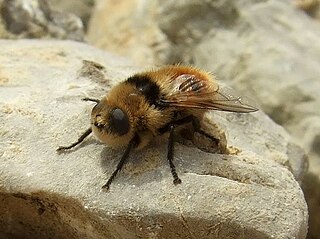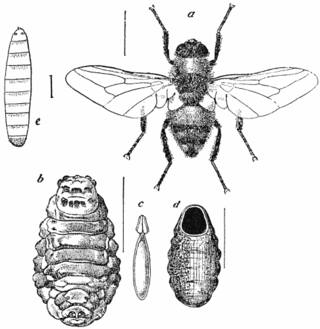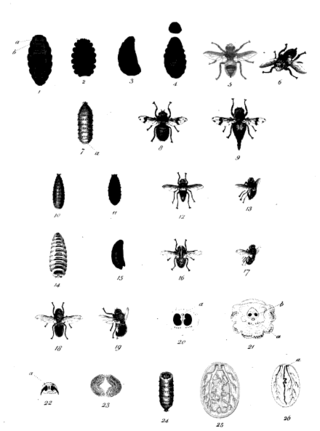
Oestroidea is a superfamily of Calyptratae including the blow flies, bot flies, flesh flies, and their relatives. It occurs worldwide and has about 15,000 described species.

Botflies, also known as warble flies, heel flies, and gadflies, are a family of flies known as the Oestridae. Their larvae are internal parasites of mammals, some species growing in the host's flesh and others within the gut. Dermatobia hominis is the only species of botfly known to parasitize humans routinely, though other species of flies cause myiasis in humans.

The Gasterophilinae are a subfamily of Oestridae which includes large, parasitic flies; this group has historically been treated as a family, but all recent classifications place them firmly within the Oestridae. Many members of this subfamily spend part of their larval stages in the digestive tracts of herbivores. The best known genus is Gasterophilus, which attacks horses, deer, and similar animals. The genus Cobboldia breeds in elephants. The genus Gyrostigma breeds in rhinoceroses.

The name deer botfly refers to any species in the genus Cephenemyia, within the family Oestridae. They are large, gray-brown flies, often very accurate mimics of bumblebees. They attack chiefly the nostrils and pharyngeal cavity of members of the deer family. The larva of Cephenemyia auribarbis, infesting the stag, is called a stagworm. The genus name comes from the Greek kēphēn, meaning 'drone bee', and myia, meaning 'fly'.

Cobboldia is a genus of parasitic flies in the family Oestridae. Adult flies of Cobboldia elephantis lay their eggs near the mouth or base of the tusks of Asian elephant while the related Cobboldia loxodontis parasitizes African elephants. The larvae hatch and develop in the mouth cavity and later move to the stomach. On maturing, the third instar larvae exit from the mouth and drop to the ground to pupate.

The Hypodermatinae are a subfamily of Oestridae. The Hypodermatinae include large parasitic flies, some of which are known as warble flies. The 9 genera in this subfamily typically spend their larval stages in the skin or soft tissues of mammals, including bovines. Such species include serious pests of livestock.

Oestrinae is a subfamily of Oestridae which includes parasitic flies attacking a range of different hosts. There are 9 genera with 34 species in this subfamily, which typically spend their larval stage in the skin or soft tissues of mammals, including deer or sheep. The adult flies give birth to living larva in the host's nostril.

The Mexican spiny pocket mouse is a species of rodent in the family Heteromyidae. It is native to Mexico and Texas in the United States where it is found in dry, scrubby habitats. The IUCN has assessed it as being of "least concern". It was formerly placed in the genus Liomys, which is now recognized to be paraphyletic and has been subsumed into Heteromys.

Oestrus is a genus of bot flies, from the family Oestridae

Cuterebra, or rodent bots, is a genus of bot flies that attack rodents and similar animals.
Cephalopsis titillator is a member of the genus of flies in the family Oestridae. It is a nasal bot fly of dromedaries.

Cephenemyia trompe, also known as the reindeer nose botfly, is a species of botfly first described by Adolph Modéer in 1786. It belongs to the deer botfly genus Cephenemyia. This fly is parasitic on reindeer. It is one of two Cephenemyia species found only in Scandinavia.
Cuterebra austeni is a species of new world skin bot flies in the family Oestridae.

Cuterebra fontinella, the mouse bot fly, is a species of New World skin bot fly in the family Oestridae. C. fontinella is typically around 1 cm (0.39 in) in length with a black and yellow color pattern. C. fontinella develops by parasitizing nutrients from its host, typically the white-footed mouse. C. fontinella has even been known to parasitize humans in rare cases. Individuals parasitized by C. fontinella will develop a large bump on the skin that is indicative of parasitization.
Cephenemyia apicata is a species of nose bot flies in the family Oestridae. Its larvae are parasites of Odocoileus hemionus columbianus, and in their first instar can be found in the deer's lungs. Adults typically mate from April through late July.
Cuterebra bajensis is a species of new world skin bot flies in the family Oestridae.
Cuterebra emasculator, the squirrel bot fly, is a species of new world skin bot fly in the family Oestridae. The species was first described by Asa Fitch in 1856. It is an internal parasite of chipmunks and tree squirrels in the eastern United States. The species' name comes from the belief that larvae ate the testicles of chipmunks. This belief is false, as parasitism by the larvae of these flies does not result in lower fertility - chipmunks mate in the spring, while botfly infections occur in the summer, and the larva do not impede sperm production as they reside below the skin.
Cuterebra cuniculi is a species of new world skin bot fly in the family Oestridae. Its range is restricted to the states of Georgia and Florida. Its larvae are parasites of the eastern cottontail and marsh rabbit.
Cuterebra tenebrosa, the rodent bot fly, is a species of new world skin bot fly in the family Oestridae.
Portschinskia is a genus of flies. They are also known as bumblebee bot flies due to their striking resemblance to bumblebees both in habit and colour patterns. Like all bot flies they are obligate parasites whose larvae develop in mammals.












